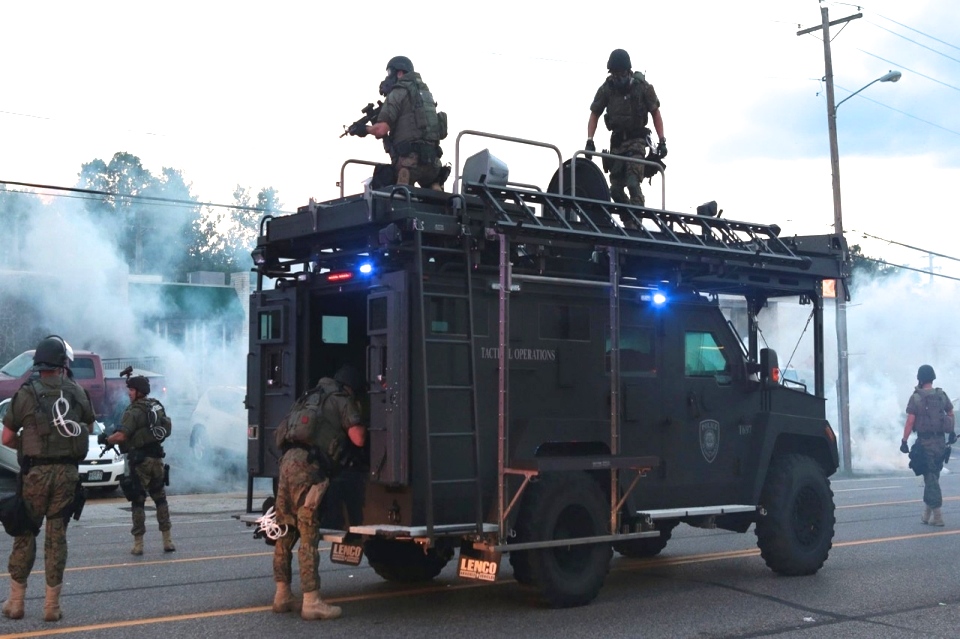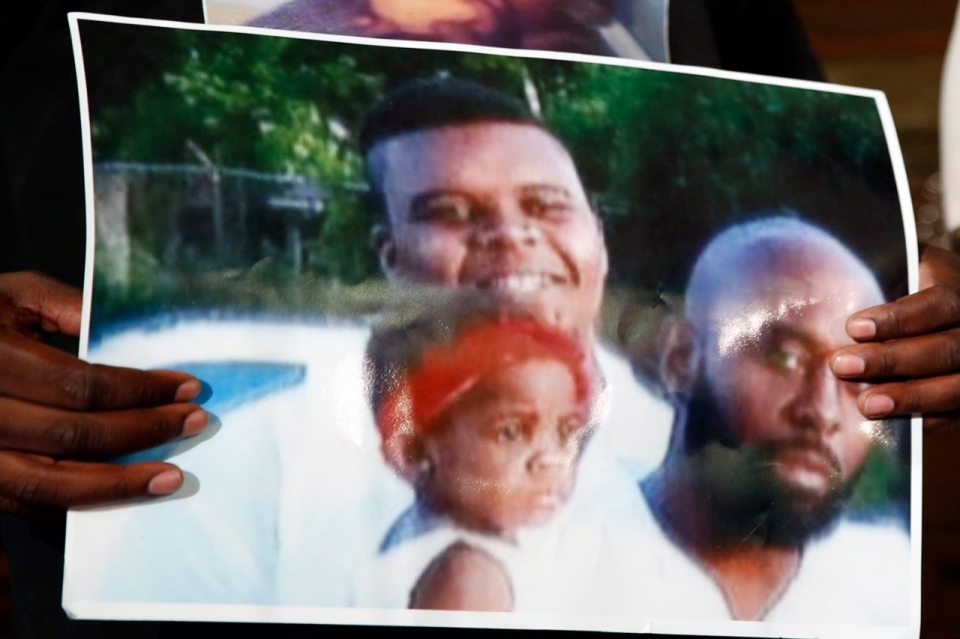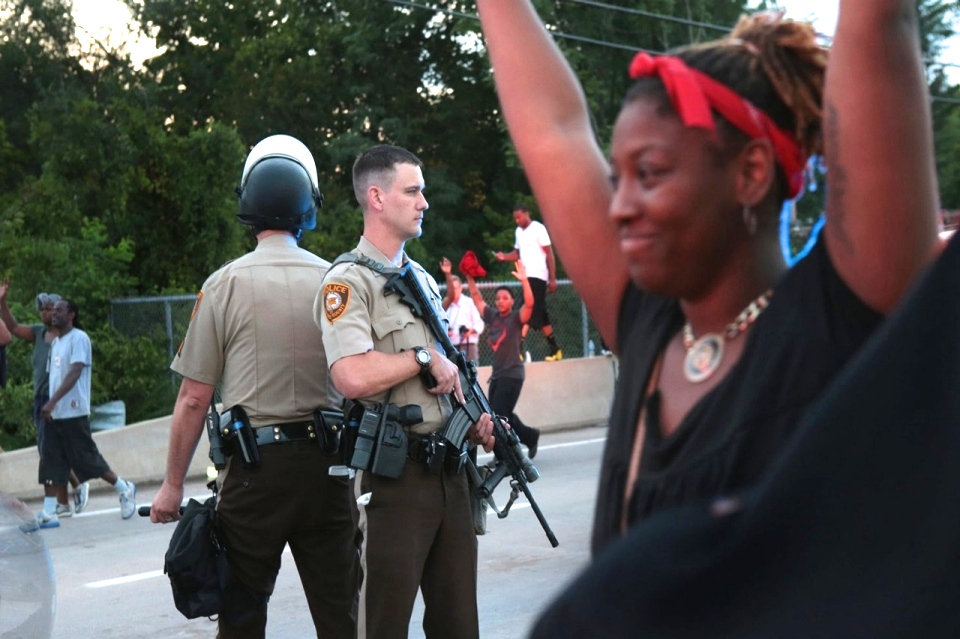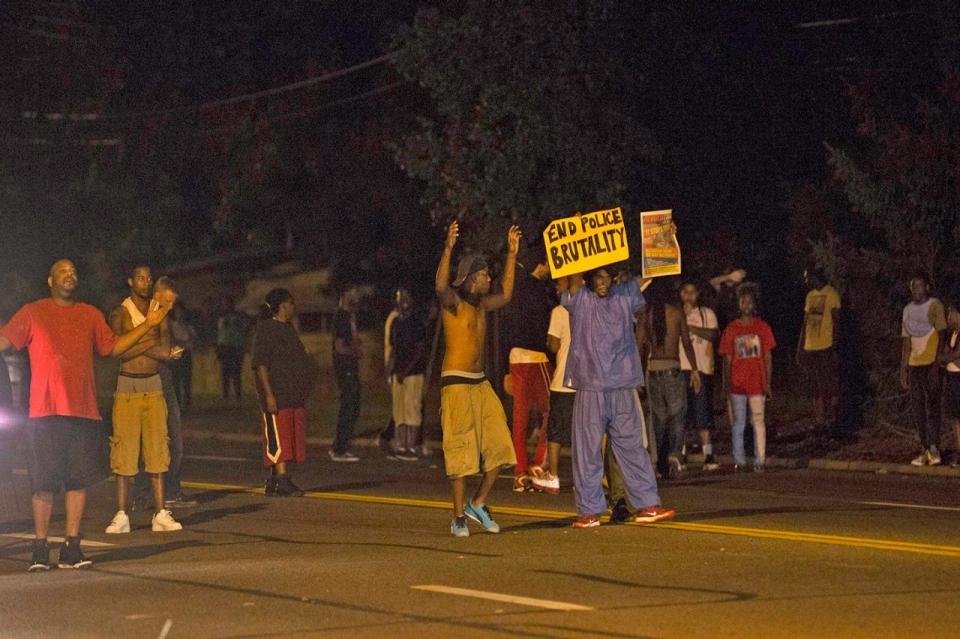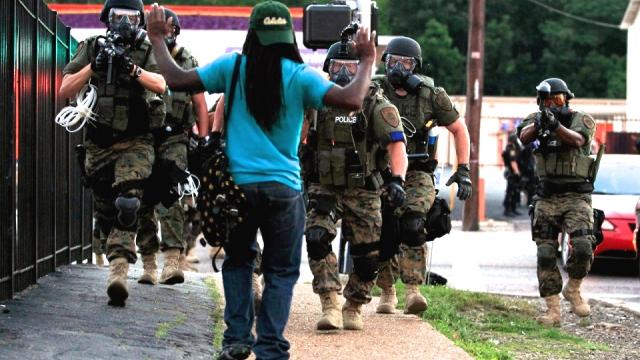
Police have cracked down hard on a second night of demonstrations over the fatal shooting on Saturday of an unarmed black 18-year-old in Missouri, driving dozens of young protesters out of the city of Ferguson with dogs, teargas and rubber bullets.
For two hours, officers from several forces clashed with a crowd that had gathered steadily through Monday near the scene of the killing of Michael Brown. While some protesters threw bricks at police, others walked with their arms aloft, saying: “Hands up, don’t shoot.”
“We were just sitting on the ground in the street, singing We Shall Not Be Moved,” Chris McMillan, a 20-year-old childhood friend of Brown’s, told the Guardian, after emerging from a fog of teargas. “They told us, ‘Get off the street’, and then they started shooting gas canisters at us.
“It felt like torture. They shot them at me twice. It was all in my face, my eyes, my chest. It was in my mouth, and I couldn’t even breathe. I didn’t move until I had to run off, because my face was burning. They kept shooting.”
As police rapidly shut down access to the city from all sides, other officers – some wearing riot gear, including gas masks – steadily forced demonstrators down West Florissant Avenue, the main drag to the east of the suburb of about 21,000 people outside St. Louis, Missouri.
Sergeant Colby Dolly, a spokesman for St. Louis county police, said at a makeshift command center early on Tuesday morning that some 150 officers had been involved in the operation and had made about 10 arrests. (The number later escalated to more than 50 arrests, according to Al Jazeera America.)
Dolly said two protesters had suffered injuries serious enough that they were taken to hospital: one who said he suffered a seizure, and another with an apparently dislocated shoulder.
But others displayed the effects of tough police tactics and said they were in pain. Amid reports of gunfire around Ferguson, one police officer wearing full riot gear described the city as “a war zone” as he ordered reporters away from a row of stores.
Steve Walsh, 26, said he was struck in the neck by a wooden pellet after becoming caught up in clashes while walking to the home of his two-month-old son, Saveon, and the child’s mother. Disoriented and drenched in sweat, Walsh had a bloody, coin-sized wound behind his left ear. “I almost fainted,” said Walsh. “Blood just started coming out. I was just walking through.”
“It felt like my eyes were about to melt out of my head. My lips are still burning,” said Jaysha Ross, 20, who said that she, too, had suffered after inhaling teargas. “They hit an old lady, and I ran back to help her. Then they threw another one.”
Dolly confirmed the tactics were used to disperse people and said that protesters had effectively fired the first shot by throwing bricks. He told the Guardian: “They were given plenty of warnings, of well over a minute, from a loudspeaker, before projectiles or munitions were used. If you really didn’t want to be exposed to that, you did have time to move away.”
Two demonstrators said that they saw people struck with cylinder-shaped pellets of about two inches in length, made of what appeared to be compacted woodchip. “I saw a man get hit on the side of his face,” said Damon Bevly, 19, who works for a recycling company. “He had a fat bruise.”
Dolly said he did not recognize the description of pellets. Chief Thomas Jackson of the Ferguson city police told reporters on Monday night that officers had been using “beanbag rounds”.
Derek Chappel, 21, offered a view of two small lumps – one on the lower right-hand side of his abdomen, the other on his right thigh – as proof that he had been shot with some kind of non-lethal projectile.
“It stung for a minute, but they ain’t stopping us,” said Chappel. “It’s real messed up, man. We [are] just trying to have a protest. They killed another young black man in America. That was my friend they shot.”
Brown, a high school graduate who had been due to begin classes at Vatterott College on Monday, was shot multiple times by a police officer near an apartment block on Saturday. His parents have said that he was walking from a convenience store.
Police chiefs say the shooting followed a struggle in the officer’s patrol car over his gun, when Brown “physically assaulted” him. Yet this was dismissed by Dorian Johnson, a friend who was walking with Brown, and Piaget Crenshaw, a witness who claims to have seen the shooting.
They say that it followed a mere exchange of words, after the young men were told to walk on the pavement rather than in the road. Friends say Brown was fleeing with his hands in the air and accuse the police of a racist attack.
The shooting is being investigated by the St. Louis county police department. The FBI is also looking into whether there are potential civil rights violations arising from it, according to a spokeswoman for the bureau’s St. Louis field office.
Gunshots rang out again earlier on Monday on the street where Brown was shot, which baked in hot, bright sunshine throughout the afternoon. A young man was seen by the Guardian firing a pistol just yards away from a makeshift memorial to the 18-year-old at about 3.30pm.
The man walked out from the parking lot of an apartment block, stood beside a dumpster and shot several times at someone across the road who could not be seen, before heading east and out of sight. At least one shot appeared to be returned.
Some mourners who were gathered at the memorial hurried to their cars and drove away. A sign propped up between soft toys and candles and declared: “We demand answers / doesn’t make us a mob / it’s democracy.”
Despite officers being stationed at nearby shops and businesses, there was no police presence near the memorial and no officers arrived following the shooting. About 40 minutes later, a yellow school bus stopped at the spot where the man had fired and let off one young schoolboy, who smiled as he walked down the sidewalk wearing a backpack on both shoulders.
Brown’s father spoke publicly about the shooting for the first time on Monday. “We need justice for our son,” Michael Brown Sr. repeated at a press conference. “We want justice for our son.” Brown’s mother, Lesley McSpadden, said: “No violence, no violence.”
The couple was supported by their attorney, Benjamin Crump, who previously represented the parents of Trayvon Martin, the 17-year-old unarmed boy who was shot dead by a neighborhood watch captain in 2012. “I don’t want to sugarcoat it – their baby was executed in broad daylight,” Crump said of Brown’s parents.
Earlier, at a town hall meeting convened at a Christian Methodist Episcopal church by the National Association for the Advancement of Colored People (NAACP), civil rights leaders pledged to get to the bottom of what happened to Brown.
“We want this man arrested, in jail, and charged for murder,” the Rev James Stewart, the pastor of the church, said of the officer involved, to loud applause. The officer, who has been placed on paid leave, has not yet been publicly identified. He is expected to be named on Tuesday.
Describing the shooting as a “cankerous sore on the soul,” Cornell Brooks, the NAACP national president, told the packed church: “We owe it to this young man to seek justice.”
Brooks urged restraint from Ferguson’s young people after several stores were vandalized and looted during rioting late on Sunday. More than 30 people were arrested. “Martin Luther King did not live and die that we may steal in the name of justice in the middle of the night,” he said.
Dolly, the police spokesman, said officers had succeeded in protecting local businesses from a second round of thefts. Asked if they were anticipating more protests on Tuesday, he said: “We are not expecting it, but we will be prepared for it.”
Yet when asked how angry people remained, McMillan, the childhood friend of Brown, said: “They on 10. From one to 10, the anger level is 10. Because this is a peaceful protest, and they’re shooting us with smoke bombs and pellets.”
A few dozen police officers, some in military-style dress, remained at the makeshift police operation command center late in a strip mall car park on Monday night, amid a sea almost 100 law-enforcement vehicles including two armored Swat trucks.
A small group of officers congregating outside a branch of Target could be heard laughing and mocking the protesters they had been dealing with earlier in the night. “Oh, don’t shoot me!” one said, prompting hearty laughter.
3 WAYS TO SHOW YOUR SUPPORT
- Log in to post comments

